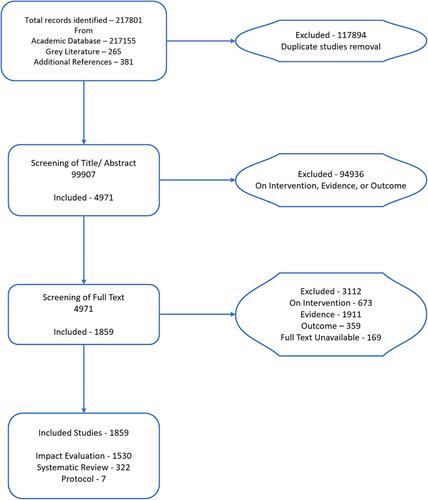Road Traffic injuries (RTI) are among the top ten leading causes of death in the world resulting in 1.35 million deaths every year, about 93% of which occur in low- and middle-income countries (LMICs). Despite several global resolutions to reduce traffic injuries, they have continued to grow in many countries. Many high-income countries have successfully reduced RTI by using a public health approach and implementing evidence-based interventions. As many LMICs develop their highway infrastructure, adopting a similar scientific approach towards road safety is crucial. The evidence also needs to be evaluated to assess external validity because measures that have worked in high-income countries may not translate equally well to other contexts. An evidence gap map for RTI is the first step towards understanding what evidence is available, from where, and the key gaps in knowledge.
The objective of this evidence gap map (EGM) is to identify existing evidence from all effectiveness studies and systematic reviews related to road safety interventions. In addition, the EGM identifies gaps in evidence where new primary studies and systematic reviews could add value. This will help direct future research and discussions based on systematic evidence towards the approaches and interventions which are most effective in the road safety sector. This could enable the generation of evidence for informing policy at global, regional or national levels.
The EGM includes systematic reviews and impact evaluations assessing the effect of interventions for RTI reported in academic databases, organization websites, and grey literature sources. The studies were searched up to December 2019.
The interventions were divided into five broad categories: (a) human factors (e.g., enforcement or road user education), (b) road design, infrastructure and traffic control, (c) legal and institutional framework, (d) post-crash pre-hospital care, and (e) vehicle factors (except car design for occupant protection) and protective devices. Included studies reported two primary outcomes: fatal crashes and non-fatal injury crashes; and four intermediate outcomes: change in use of seat belts, change in use of helmets, change in speed, and change in alcohol/drug use. Studies were excluded if they did not report injury or fatality as one of the outcomes.
The EGM is presented in the form of a matrix with two primary dimensions: interventions (rows) and outcomes (columns). Additional dimensions are country income groups, region, quality level for systematic reviews, type of study design used (e.g., case-control), type of road user studied (e.g., pedestrian, cyclists), age groups, and road type. The EGM is available online where the matrix of interventions and outcomes can be filtered by one or more dimensions. The webpage includes a bibliography of the selected studies and titles and abstracts available for preview. Quality appraisal for systematic reviews was conducted using a critical appraisal tool for systematic reviews, AMSTAR 2.
The EGM identified 1859 studies of which 322 were systematic reviews, 7 were protocol studies and 1530 were impact evaluations. Some studies included more than one intervention, outcome, study method, or study region. The studies were distributed among intervention categories as: human factors (n = 771), road design, infrastructure and traffic control (n = 661), legal and institutional framework (n = 424), post-crash pre-hospital care (n = 118) and vehicle factors and protective devices (n = 111). Fatal crashes as outcomes were reported in 1414 records and non-fatal injury crashes in 1252 records. Among the four intermediate outcomes, speed was most commonly reported (n = 298) followed by alcohol (n = 206), use of seatbelts (n = 167), and use of helmets (n = 66). Ninety-six percent of the studies were reported from high-income countries (HIC), 4.5% from upper-middle-income countries, and only 1.4% from lower-middle and low-income countries. There were 25 systematic reviews of high quality, 4 of moderate quality, and 293 of low quality.
The EGM shows that the distribution of available road safety evidence is skewed across the world. A vast majority of the literature is from HICs. In contrast, only a small fraction of the literature reports on the many LMICs that are fast expanding their road infrastructure, experiencing rapid changes in traffic patterns, and witnessing growth in road injuries. This bias in literature explains why many interventions that are of high importance in the context of LMICs remain poorly studied. Besides, many interventions that have been tested only in HICs may not work equally effectively in LMICs. Another important finding was that a large majority of systematic reviews are of low quality. The scarcity of evidence on many important interventions and lack of good quality evidence-synthesis have significant implications for future road safety research and practice in LMICs. The EGM presented here will help identify priority areas for researchers, while directing practitioners and policy makers towards proven interventions.



